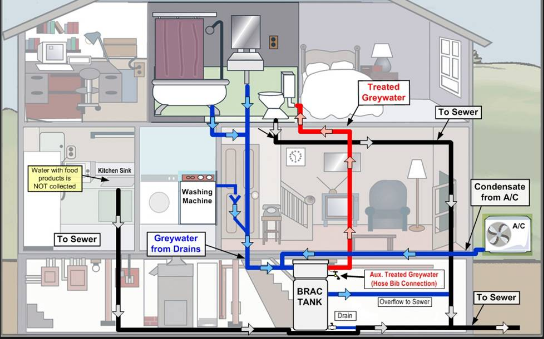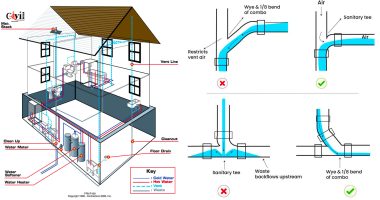In this article below yow will discover more excellent guidance in relation to Plumbing Installation 101: All You Need to Know.

Recognizing exactly how your home's pipes system functions is vital for every home owner. From delivering clean water for alcohol consumption, cooking, and bathing to securely eliminating wastewater, a well-maintained plumbing system is vital for your family's health and wellness and convenience. In this comprehensive overview, we'll discover the intricate network that comprises your home's pipes and deal tips on maintenance, upgrades, and managing typical issues.
Intro
Your home's plumbing system is more than simply a network of pipes; it's an intricate system that guarantees you have access to tidy water and efficient wastewater elimination. Knowing its parts and how they interact can aid you prevent pricey repairs and ensure every little thing runs efficiently.
Fundamental Parts of a Pipes System
Pipes and Tubes
At the heart of your plumbing system are the pipelines and tubes that carry water throughout your home. These can be made from different materials such as copper, PVC, or PEX, each with its benefits in terms of toughness and cost-effectiveness.
Fixtures: Sinks, Toilets, Showers, and so on.
Fixtures like sinks, toilets, showers, and bath tubs are where water is used in your house. Recognizing just how these components attach to the pipes system assists in detecting troubles and intending upgrades.
Shutoffs and Shut-off Factors
Shutoffs manage the circulation of water in your pipes system. Shut-off shutoffs are vital throughout emergency situations or when you need to make repair services, allowing you to separate parts of the system without interfering with water circulation to the entire house.
Supply Of Water System
Main Water Line
The main water line links your home to the local water or a private well. It's where water enters your home and is dispersed to numerous components.
Water Meter and Stress Regulator
The water meter steps your water usage, while a pressure regulator guarantees that water flows at a safe stress throughout your home's pipes system, protecting against damages to pipes and components.
Cold Water vs. Hot Water Lines
Understanding the difference in between cold water lines, which supply water directly from the major, and hot water lines, which carry warmed water from the water heater, aids in repairing and preparing for upgrades.
Drainage System
Drain Pipes Water Lines and Traps
Drain pipes lug wastewater away from sinks, showers, and bathrooms to the sewer or septic system. Traps protect against drain gases from entering your home and also catch debris that could create clogs.
Air flow Pipes
Air flow pipes permit air into the drain system, protecting against suction that might slow water drainage and cause catches to empty. Correct ventilation is vital for preserving the stability of your pipes system.
Significance of Correct Water Drainage
Guaranteeing correct drain protects against backups and water damages. Consistently cleaning drains pipes and maintaining traps can protect against costly fixings and prolong the life of your pipes system.
Water Heater
Types of Hot Water Heater
Water heaters can be tankless or typical tank-style. Tankless heaters warm water on demand, while storage tanks save heated water for instant usage.
Updating Your Plumbing System
Reasons for Upgrading
Upgrading to water-efficient components or changing old pipes can improve water high quality, lower water expenses, and boost the worth of your home.
Modern Plumbing Technologies and Their Benefits
Explore innovations like clever leakage detectors, water-saving bathrooms, and energy-efficient hot water heater that can conserve cash and lower ecological impact.
Cost Considerations and ROI
Calculate the upfront expenses versus long-lasting cost savings when thinking about pipes upgrades. Lots of upgrades spend for themselves with minimized energy costs and less fixings.
Just How Water Heaters Attach to the Plumbing System
Understanding how water heaters connect to both the cold water supply and hot water circulation lines helps in identifying concerns like not enough warm water or leakages.
Maintenance Tips for Water Heaters
On a regular basis purging your water heater to eliminate sediment, inspecting the temperature settings, and inspecting for leakages can expand its life-span and boost power effectiveness.
Typical Plumbing Concerns
Leakages and Their Causes
Leaks can happen because of aging pipes, loosened installations, or high water pressure. Addressing leakages promptly protects against water damages and mold growth.
Obstructions and Obstructions
Blockages in drains and commodes are often caused by purging non-flushable products or a buildup of oil and hair. Making use of drain displays and being mindful of what decreases your drains pipes can prevent clogs.
Indicators of Plumbing Troubles to Look For
Low tide stress, slow drains, foul odors, or abnormally high water costs are indications of prospective plumbing issues that should be dealt with immediately.
Pipes Maintenance Tips
Normal Assessments and Checks
Schedule yearly plumbing inspections to capture problems early. Look for indicators of leaks, deterioration, or mineral accumulation in faucets and showerheads.
Do It Yourself Maintenance Tasks
Straightforward jobs like cleaning tap aerators, checking for bathroom leaks making use of dye tablet computers, or protecting exposed pipelines in cold climates can prevent major plumbing concerns.
When to Call a Professional Plumbing Professional
Know when a plumbing concern needs specialist competence. Attempting intricate repair work without correct knowledge can bring about more damage and greater repair service prices.
Tips for Decreasing Water Use
Simple routines like fixing leaks immediately, taking shorter showers, and running complete lots of laundry and meals can preserve water and lower your utility expenses.
Eco-Friendly Plumbing Options
Consider lasting pipes materials like bamboo for flooring, which is durable and environment-friendly, or recycled glass for kitchen counters.
Emergency Readiness
Actions to Take During a Plumbing Emergency
Know where your shut-off shutoffs lie and just how to turn off the water in case of a ruptured pipeline or significant leak.
Significance of Having Emergency Situation Calls Helpful
Maintain call information for neighborhood plumbing technicians or emergency situation solutions readily offered for quick response throughout a pipes crisis.
Ecological Impact and Preservation
Water-Saving Fixtures and Devices
Installing low-flow faucets, showerheads, and bathrooms can substantially lower water usage without compromising efficiency.
Do It Yourself Emergency Situation Fixes (When Relevant).
Short-lived fixes like using air duct tape to spot a dripping pipeline or positioning a pail under a trickling tap can decrease damage until a professional plumbing shows up.
Conclusion.
Understanding the anatomy of your home's plumbing system empowers you to keep it properly, conserving money and time on repair work. By complying with regular maintenance routines and remaining educated regarding modern plumbing modern technologies, you can guarantee your plumbing system operates efficiently for several years ahead.
Exploring Your Homes Plumbing Anatomy
Water Supply System
Main Water Line: This is where water enters your home from the municipal supply or a private well. Water Meter: Typically located near where the main water line enters the property, it measures the amount of water used. Shutoff Valve: It s crucial to know where this is in case of emergencies. It allows you to turn off the water supply to the entire house. Pipes and Fittings: These distribute water throughout your home. Materials can include copper, PVC, or PEX. Drain-Waste-Vent (DWV) System
Drains: Located in sinks, showers, and tubs, these carry wastewater away. Traps: U-shaped pipes under sinks that hold standing water, blocking sewer gases from entering the home. Vents: Pipes that lead from the DWV system to the outside, preventing vacuum formation and allowing gases to escape. Sewer Line: Carries all wastewater from the home to the municipal sewer system or a septic tank. Fixtures and Appliances
Sinks, Toilets, and Showers Dishwashers and Washing Machines Water Heaters Maintenance Tips
Regularly check for leaks in exposed pipes and around fixtures. Inspect the water heater annually for signs of wear. Clean drains and traps to prevent clogs and odors. Know how to shut off water to individual fixtures. When to Call a Professional
Major leaks or burst pipes Installation of new pipes or fixtures Septic tank issues Remodeling projects that involve plumbing changes Conclusion
Understanding the anatomy of your home's plumbing is key to maintaining a functional and efficient system. Regular checks and knowing when to call in the experts can save you time, money, and stress.
https://www.mavyn.com/blog/exploring-your-homes-plumbing-anatomy

We had been introduced to that article on Plumbing Installation 101: All You Need to Know through an associate on a different web page. If you please pause to promote this content if you appreciated it. I recognize the value of your readership.
Estimating